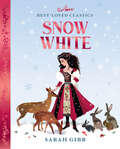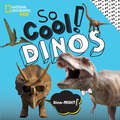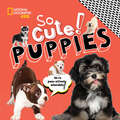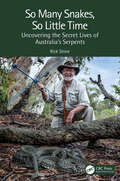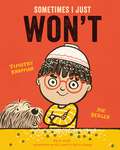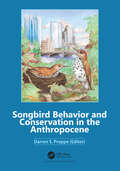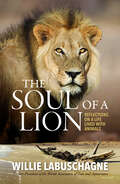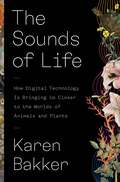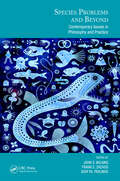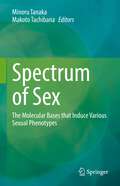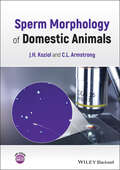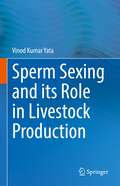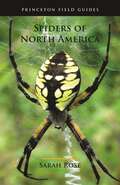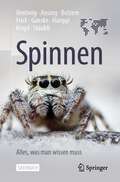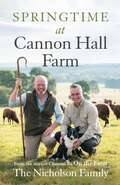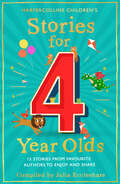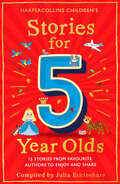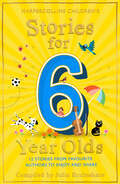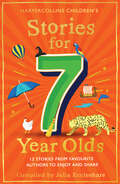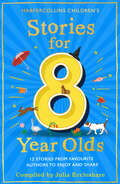- Table View
- List View
Snow White (Best-Loved Classics)
by Sarah GibbA beautifully illustrated, magical retelling of one of the most beloved children’s fairy tales.
So Cool! Dinos (National Geographic Kids)
by National Geographic KidsThose sharp, pointy teeth! Those terrifying claws! Those spikey spines and ferocious roars! Let's face it…dinosaurs are SO COOL! And, well, so is this book!
So Cute! Puppies (National Geographic Kids)
by National Geographic KidsThat wrinkly little face. Those sweet puppy dog eyes. That squishy, pudgy, fuzzy body…let's face it: Puppies are SO CUTE! And, well, so is this book!
So Many Snakes, So Little Time: Uncovering the Secret Lives of Australia’s Serpents
by Rick ShineSnakes are creatures of mystery, arousing fear in many people but fascination in a few. Recent research has transformed our understanding of the behaviour and ecology of these animals, revealed their important roles in diverse ecosystems, and discovered new and effective ways to conserve their populations and to promote coexistence between snakes and people. One of the leading contributors to that scientific revolution has been Prof Rick Shine. Based in Australia, whose snake fauna is diverse and often dangerous, his experiences and anecdotes will inspire a new generation of serpent scientists. Spellbinding stories highlight the challenges, frustrations, and joys of discovery, and give the reader a greater appreciation of these often-slandered slithering reptiles.Key Features Documents the important role played by a preeminent herpetologist. Focuses on research conducted in Australia, especially on snakes. Summarizes highly influential conservation studies. Explores the ways in which research has deepened our understanding of snakes.
So Many Snakes, So Little Time: Uncovering the Secret Lives of Australia’s Serpents
by Rick ShineSnakes are creatures of mystery, arousing fear in many people but fascination in a few. Recent research has transformed our understanding of the behaviour and ecology of these animals, revealed their important roles in diverse ecosystems, and discovered new and effective ways to conserve their populations and to promote coexistence between snakes and people. One of the leading contributors to that scientific revolution has been Prof Rick Shine. Based in Australia, whose snake fauna is diverse and often dangerous, his experiences and anecdotes will inspire a new generation of serpent scientists. Spellbinding stories highlight the challenges, frustrations, and joys of discovery, and give the reader a greater appreciation of these often-slandered slithering reptiles.Key Features Documents the important role played by a preeminent herpetologist. Focuses on research conducted in Australia, especially on snakes. Summarizes highly influential conservation studies. Explores the ways in which research has deepened our understanding of snakes.
Sometimes I Just WON'T
by Timothy KnapmanSometimes I Just WON'T is a hilarious and helpful book about the ever-changing moods of small children, from top picture book pairing, Timothy Knapman and Joe Berger.Being a toddler is an emotional rollercoaster. Some days you want to put your coat on, you don’t mind sharing and you can't wait to have your bath. There are days when you're the first to slide down the biggest slide, or join in with everyone else. But some days, you just WON'T! And sometimes that’s OK. But, with a little kindness and encouragement, you might find that something you don’t want to do can become something you love to do!A comic look at child autonomy and how to navigate strong emotions. An essential read for all young children – and their adults because, big or small, sometimes we ALL need to feel in charge. With bouncing rhythmic text and lively, graphic illustrations this is a brilliant follow up to Sometimes I am Furious, a Sunday Times Book of the Year 2021!
Songbird Behavior and Conservation in the Anthropocene
by Darren S. ProppeLearned and fixed behaviors underlie many of the patterns we observe in songbirds. But the environmental context in which these patterns occur is changing quickly, often to the detriment of the individual and species. The goal of this book is to weave concepts of behavior more tightly into our conservation strategies. Each chapter describes the current understanding of behavior in relation to a particular songbird life history trait. The authors then evaluate challenges that songbirds face in the Anthropocene, and explore the role of behavior in addressing these challenges. The future is uncertain for songbirds, but broadening our management toolkit will increase the potential for success.
Songbird Behavior and Conservation in the Anthropocene
by Darren S. ProppeLearned and fixed behaviors underlie many of the patterns we observe in songbirds. But the environmental context in which these patterns occur is changing quickly, often to the detriment of the individual and species. The goal of this book is to weave concepts of behavior more tightly into our conservation strategies. Each chapter describes the current understanding of behavior in relation to a particular songbird life history trait. The authors then evaluate challenges that songbirds face in the Anthropocene, and explore the role of behavior in addressing these challenges. The future is uncertain for songbirds, but broadening our management toolkit will increase the potential for success.
The Soul of a Lion: Reflections on a life lived with animals
by Willie LabuschagneThe Soul of a Lion, an engaging memoir by Willie Labuschagne, is an exhilarating journey which begins with the young conservationist’s unique experiences with wild animals. From his groundbreaking research on the desert cheetah’s behaviour and ecology to becoming an internationally respected consultant on environmental and wildlife-related issues, he holds the reader’s attention with all the skill of the master storyteller.The numerous occasions when Willie faced potentially life-threatening situations with wild animals are vividly recounted, many of them wryly humorous while others evoke deep emotion.But not all animal encounters took place in the wild. A significant and poignant encounter that further inspired Willie’s approach to conservation occurred when, during his time as director of the Johannesburg Zoo, he and his family hand-raised a newborn lion cub that had been rejected by its mother.He recalls the countless obstacles put in his way by the bureaucratic nature of his own species during his tenure at the zoo. But despite numerous challenges he persisted in his goal of transforming and improving zoological institutions. A driving force behind the changing nature of professionally managed zoological gardens, Willie’s book reminds us that, while many of the world’s zoos should be unconditionally closed, progressive modern zoos are becoming increasingly aligned to wildlife conservation: they are vital for ensuring the survival of threatened species.Willie shares his entertaining and often moving life experiences with warmth and understanding, whether it is sleeping under the stars with the bushmen of the Kgalagadi desert or observing the traditions of the Zulu Royal House. His travels in the African landscape in particular are an exciting panorama of many distinctive habitats, from the relentless desert of the Skeleton Coast in Namibia to the pristine beauty of the Tsitsikamma Forest and the breathtaking vastness of the African bushveld.Importantly, he is forthright in his view of the critical position of the world we live in and the future it holds for mankind and believes that we are all part of a custodianship which should do everything in its power to protect our fragile environment.Willie Labuschagne, a man with the soul of a lion, is a dedicated and internationally celebrated wildlife conservationist who holds a master’s degree in wildlife management. For more than five decades he has been actively involved in the conservation of threatened species for which he has received national and international recognition, culminating in numerous awards.
The Sounds of Life: How Digital Technology Is Bringing Us Closer to the Worlds of Animals and Plants
by Karen BakkerAn amazing journey into the hidden realm of nature&’s soundsThe natural world teems with remarkable conversations, many beyond human hearing range. Scientists are using groundbreaking digital technologies to uncover these astonishing sounds, revealing vibrant communication among our fellow creatures across the Tree of Life.At once meditative and scientific, The Sounds of Life shares fascinating and surprising stories of nonhuman sound, interweaving insights from technological innovation and traditional knowledge. We meet scientists using sound to protect and regenerate endangered species from the Great Barrier Reef to the Arctic and the Amazon. We discover the shocking impacts of noise pollution on both animals and plants. We learn how artificial intelligence can decode nonhuman sounds, and meet the researchers building dictionaries in East African Elephant and Sperm Whalish. At the frontiers of innovation, we explore digitally mediated dialogues with bats and honeybees. Technology often distracts us from nature, but what if it could reconnect us instead?The Sounds of Life offers hope for environmental conservation and affirms humanity&’s relationship with nature in the digital age. After learning about the unsuspected wonders of nature&’s sounds, we will never see walks outdoors in the same way again.
Species Problems and Beyond: Contemporary Issues in Philosophy and Practice (Species and Systematics)
by John S. Wilkins Frank E. Zachos Igor Ya. PavlinovSpecies Problems and Beyond offers a collection of up-to-date essays discussing from an interdisciplinary perspective the many ramifications of the ‘Species Problem.’ The authors represent experts in the philosophy of biology, in species-level evolutionary investigations, and in biodiversity studies and conservation. Some of the topics addressed concern the context sensitivity of the term ‘species’; species as individuals, processes, natural kinds, or as ‘operative concepts’; species delimitation in the age of Big (genomic) Data; and taxonomic inflation and its consequences for conservation strategies. The carefully edited volume will be an invaluable resource for philosophers of biology and evolutionary biologists alike. – Olivier Rieppel, Rowe Family Curator of Evolutionary Biology, Negaunee Integrative Research Center, Field Museum, USASpecies, or ‘the Species Problem’, is a topic in science, in the philosophy of science, and in general philosophy. In fact, it encompasses many aspects of the same problem, and these are dealt with in this volume. Species are often thought of as fundamental units of biological matter to be used in ecology, conservation, classification, and biodiversity. The chapters in this book present opposing views on the current philosophical and conceptual issues of the Species Problem in biology.Divided into four sections, Concepts and Theories, Practice and Methods, Ranks and Trees and Names, and Metaphysics and Epistemologies, the book is authored by biologists, philosophers, and historians, many leaders in their fields. Topics include ontology of species, definitions of both species category and units, species rank, speciation issues, nomenclature, ecology, and species conservation.Species Problems and Beyond aims to clarify the contemporary issues of the Species Problem. It is ideal for use in upper-level seminars and courses in Evolutionary Biology, Philosophy of Science, Philosophy of Biology, Systematics and Taxonomy, and Phylogenetics/Cladistics, and for any scholar in these fields.
Species Problems and Beyond: Contemporary Issues in Philosophy and Practice (Species and Systematics)
by John S. Wilkins, Frank E. Zachos, and Igor Ya. PavlinovSpecies Problems and Beyond offers a collection of up-to-date essays discussing from an interdisciplinary perspective the many ramifications of the ‘Species Problem.’ The authors represent experts in the philosophy of biology, in species-level evolutionary investigations, and in biodiversity studies and conservation. Some of the topics addressed concern the context sensitivity of the term ‘species’; species as individuals, processes, natural kinds, or as ‘operative concepts’; species delimitation in the age of Big (genomic) Data; and taxonomic inflation and its consequences for conservation strategies. The carefully edited volume will be an invaluable resource for philosophers of biology and evolutionary biologists alike. – Olivier Rieppel, Rowe Family Curator of Evolutionary Biology, Negaunee Integrative Research Center, Field Museum, USASpecies, or ‘the Species Problem’, is a topic in science, in the philosophy of science, and in general philosophy. In fact, it encompasses many aspects of the same problem, and these are dealt with in this volume. Species are often thought of as fundamental units of biological matter to be used in ecology, conservation, classification, and biodiversity. The chapters in this book present opposing views on the current philosophical and conceptual issues of the Species Problem in biology.Divided into four sections, Concepts and Theories, Practice and Methods, Ranks and Trees and Names, and Metaphysics and Epistemologies, the book is authored by biologists, philosophers, and historians, many leaders in their fields. Topics include ontology of species, definitions of both species category and units, species rank, speciation issues, nomenclature, ecology, and species conservation.Species Problems and Beyond aims to clarify the contemporary issues of the Species Problem. It is ideal for use in upper-level seminars and courses in Evolutionary Biology, Philosophy of Science, Philosophy of Biology, Systematics and Taxonomy, and Phylogenetics/Cladistics, and for any scholar in these fields.
Spectrum of Sex: The Molecular Bases that Induce Various Sexual Phenotypes
by Minoru Tanaka Makoto TachibanaThis book introduces cutting-edge studies on the spectrum of sex. The sex spectrum can be understood as an interwoven mechanism sustaining graded phenotypes between the two sexes. The book overviews three elements that develop the sex spectrum: genetics, the endocrine system, and the environment. Part I discusses the genetic regulation during sex determination, which often results in a mixture of two sexes or sex reversal. The evolutionary aspects of the genetic determinants are also discussed. Part II presents the involvement of endocrine regulation in the sex spectrum, which covers a broad range of phenotypic events, including sexual behavior and metabolism. Interestingly, sex hormones can also act as sex determinants. Finally, Part III shows that intrinsic factors, such as sex-determining genes and sex hormones, are not the only factors in sex development. The environment surrounding organisms, such as symbiosis and metabolism, act on the sex as critical factors, generating the sex spectrum. Determination and development of the two sexes have been a topic of great interest and a long-standing issue in biology. The book updates the conventional view that biological sex is fixed after birth and sets new perspectives for understanding sex as a spectrum manifested in multiple phenomena. Each chapter contributed by leading experts explains the sex spectrum in various organisms and their underlying mechanisms from the latest ongoing studies. The book provides a valuable resource for not only experts in developmental biology, physiology, and medical science, but also non-scientists and anyone interested in the topic.
Sperm Morphology of Domestic Animals
by Jennifer Koziol Chance ArmstrongSperm Morphology of Domestic Animals A practical guide to interpreting sperm morphology of domestic animals Sperm Morphology of Domestic Animals is a concise, clinically-oriented resource for discovering any impairment to fertility caused by sperm anomalies in domesticated animals. As a bench-side reference, the book examines common sperm defects, their causes, and their prognosis for fertility. An easy-to-use reference, it is organized according to the placement of the deformity in the sperm to increase the speed of consultation, and to help with diagnosing fertility issues. Focusing particularly on the bull, stud horse, boar, ram, buck, and dog, it contains hundreds of high-quality color images accompanied by brief descriptions for additional diagnostic help. Readers will find: An easy-to-use reference work that is suitable for use next to the microscope Organization according to location of abnormality Hundreds if high-quality color images for easy comparison Brief descriptions accompanying each photo, for additional diagnostic help An ideal resource for veterinarians, andrologists, and veterinary students, Sperm Morphology of Domestic Animals fills a gap in current reproductive medicine resources with detailed information that is easy to consult.
Sperm Morphology of Domestic Animals
by Jennifer Koziol Chance ArmstrongSperm Morphology of Domestic Animals A practical guide to interpreting sperm morphology of domestic animals Sperm Morphology of Domestic Animals is a concise, clinically-oriented resource for discovering any impairment to fertility caused by sperm anomalies in domesticated animals. As a bench-side reference, the book examines common sperm defects, their causes, and their prognosis for fertility. An easy-to-use reference, it is organized according to the placement of the deformity in the sperm to increase the speed of consultation, and to help with diagnosing fertility issues. Focusing particularly on the bull, stud horse, boar, ram, buck, and dog, it contains hundreds of high-quality color images accompanied by brief descriptions for additional diagnostic help. Readers will find: An easy-to-use reference work that is suitable for use next to the microscope Organization according to location of abnormality Hundreds if high-quality color images for easy comparison Brief descriptions accompanying each photo, for additional diagnostic help An ideal resource for veterinarians, andrologists, and veterinary students, Sperm Morphology of Domestic Animals fills a gap in current reproductive medicine resources with detailed information that is easy to consult.
Sperm Sexing and its Role in Livestock Production
by Vinod Kumar YataThis book presents basic principles and discusses the state-of-the-art methods of sperm sexing in livestock. It reviews the challenges and critical opinions on the conventional sperm sexing methods and characteristic features of spermatozoa of farm animals which could help to develop novel methods of sperm sexing. The book also presents principles and applications of flow cytometry for sperm separation. The chapters of the book elucidate methods and difficulties in developing sperm sexing methods. Notably, it covers recent research on immunological and nanotechnology-based sperm sexing methods. The book also provides information on the development of semen extenders. Towards the end, the book examines ethical and commercial aspects of sperm sexing. It is an ideal reference book for students, researchers and professionals working towards improving livestock production.
Spider 3 (tactile)
by Sheffield Vi ServiceThis is an unlabelled image of a spider seen from the top and facing to the left.
Spiders of North America (Princeton Field Guides #154)
by Common Spiders o Sarah RoseAn accessible field guide to more than 500 of the most commonly found spider species in North AmericaOf the more than 49,000 species of spider worldwide, some 4,000 are in North America. Spiders of North America explores more than 500 of the most common and interesting spiders found in this region of the world. This richly illustrated guide begins with an overview of spiders—what they are exactly, how they can be found, how they develop, and why they are important. The book features information on all the major spider guilds: sensing web weavers, sheet web weavers, orb web weavers, space web weavers, ambush hunters, ground active hunters, other active hunters, and spider hunters. Chapters contain accessible descriptions for identifying members of each spider family, including helpful tips for distinguishing members of similar families, and details at the genus and species levels. Stunning color photographs and informative distribution maps accompany the text.Useful descriptions for identification of each spider familyStunningly detailed macro and in-situ photographsInformation on all the major spider guildsHandy distribution maps
Spinnen - Alles, was man wissen muss
by Wolfgang Nentwig Jutta Ansorg Angelo Bolzern Holger Frick Anne-Sarah Ganske Ambros Hänggi Christian Kropf Anna StäubliSpinnen sind Super-Raubtiere und vertilgen alles, was sie überwältigen können. Dafür haben sie unglaublich gute Fangtechniken und mit der Spinnenseide ein Werkzeug entwickelt, das die Materialtechnik vor Neid erblassen lässt. Die Männchen sind meist kleiner als die Weibchen und müssen sich, um nicht als leichte Beute missverstanden zu werden, beim Sex einiges einfallen lassen: Tanzen, Trommeln und Geschenke helfen fast immer. Spinnen benutzen ihr Gift sehr genau dosiert, und da der Mensch nicht auf ihrem Speisezettel steht, sind sie für uns harmlos. Die (unnötige) Angst vieler Menschen vor Spinnen findet kulturelle Wurzeln bereits im Mittelalter. Trotzdem ist Spinnenangst leicht therapierbar. Es gibt weder einen Lebensraum noch ein Gebäude ohne Spinnen. Und das ist gut so, denn sie verfügen über faszinierende Eigenschaften und ihre Welt ist voller Überraschungen. Alles, was man hierzu wissen muss, wird in diesem Buch in verständlicher Sprache von Fachleuten für Laien erklärt. Zudem werden einige der häufigsten Spinnenarten in Haus und Garten mit Tipps zur Beobachtung kurz vorgestellt.
Springtime at Cannon Hall Farm
by The Nicholson FamilyJoin the Nicholson family for this heartwarming journey through a typical springtime on their South Yorkshire farm. Throughout the book they reflect on the childhood stories, testing times, poignant memories and enriching experiences that have shaped the lives they lead today. With the coming of a new season, Roger and Cynthia Nicholson and their sons Richard, Robert and David show how the farming year is shaped around the arrival of baby goats, lambs, calves and piglets galore.As Yorkshire's premier open farm attraction, Cannon Hall Farm continues to play host to thousands of visitors and spring is the busiest time of the year. People flock to meet the new arrivals and catch up with old favourites such as the llama and alpaca posse, the stunning Shire horses and the irrepressible Shetland ponies, including Ozzy Horsebourne and Jon Bon Pony.Along with all the animal antics, Springtime at Cannon Hall Farm features tales of bygone days when traditional skills, crafts and daily practices shaped life in the countryside. And for fans of Rob and Dave's Channel 5 shows, there are lots of behind-the-scenes secrets you won't want to miss...
Stories for 4 Year Olds
by Julia EccleshareA classic collection of tales to tell children of about four, featuring beloved characters and lively stories, by Michael Bond, Jill Barklem, Anne Fine amongst others, chosen by children’s book expert, Julia Eccleshare.
Stories for 5 Year Olds
by Julia EccleshareA classic collection of tales for young readers of about five, featuring beloved characters and lively stories by Michael Bond, Jill Barklem, Elizabeth Laird and others, chosen by children’s book expert, Julia Eccleshare.
Stories for 6 Year Olds
by Julia EccleshareA classic collection of tales for young readers of about six, featuring beloved characters and lively stories by P.L. Travers, Jill Barklem, Michael Morpurgo and others, chosen by children’s book expert, Julia Eccleshare.
Stories for 7 Year Olds
by Julia EccleshareA classic collection of stories by P.L Travers, Penelope Lively, Michael Morpurgo, Michael Rosen, Alexander McCall Smith and others, specially chosen for young readers of around seven by children’s book expert, Julia Eccleshare.
Stories for 8 Year Olds
by Julia EccleshareA classic collection of stories by Michael Rosen, Alexander McCall Smith, Ted Hughes, Michael Morpurgo and others, specially chosen for young readers of around eight by children’s book expert, Julia Eccleshare.
